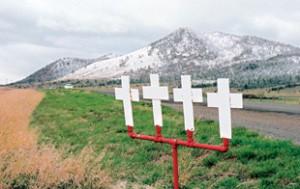Mourning Becomes Montana
In Eugene O’Neill’s Pulitzer Prize-winning trilogy, Mourning Becomes Electra, the protagonist’s grief becomes her source of strength. The sorrow shared by family and friends of those who have perished on Montana roads is also, in a way, a source of strength: it develops the resolve to pay creative tribute. And this tribute, in the form of decorated roadside crosses, becomes Montana. They’re sources of beauty that touch all who pass by.
In 2005, 249 people died in 21,733 accidents on Montana roads. Over 100 of those accidents were alcohol related and could easily have been prevented.
Fifty-three years ago, the Montana American Legion launched a program designed to remind motorists of the state’s driving fatalities and, indirectly, caution them to drive with care and sobriety. According to Tom Jones of Bozeman's American Legion Post No. 14, "When people see those crosses it makes them slow down. And it makes them pay attention to what they're doing. That's one of the main reasons the American Legion started the program."
The White Cross Fatality Marker program began in Missoula after six motorists died in local traffic accidents during the 1952 Labor Day weekend. The program was the brainchild of Hellgate Post No. 27's Floyd Eaheart. A few months after its inception, Legion posts throughout the state adopted the program.
After the Montana Highway Commission approved the program in January of 1953, most of the state’s 132 Legion posts became involved. Since the white cross program's inception, 50 years ago, it is estimated that over 2,000 white crosses have been erected along Montana's highways. The location of each cross is based on information given to the Legion posts by the State Highway Commission.
The Legion headquarters in Helena supplies all state posts with specifications for constructing the crosses. Most posts have the crosses made locally. They're painted with reflective or aluminum paint and stand at least 48" above the ground.. Some posts place reflective tape around the border of the crosses. One cross per fatality is erected at each accident site. Within city limits, some Legion posts stencil crosses on the streets where traffic deaths have occurred.
Families of accident victims often contact the American Legion with requests for crosses. If families oppose the placement of a cross, however, the Legion respects their wishes. Families or friends of the victims usually put up decorations on the crosses. Legionnaires maintain the crosses within the jurisdiction of their posts. Billboards explaining the purpose of the crosses have been erected by Legion Posts near the Canadian border and at other state lines.
Although the White Cross program had languished due to lack of funding, it was revived about sixteen years ago, thanks mainly to an influx of public donations. Legionnaires donate their time and labor to this program, but each cross costs about $30 to manufacture.
Jones has erected many of the four dozen crosses in the Gallatin Valley, and says one incident is clearly etched in his memory. The family of a 23-year-old man who was killed in an alcohol-related accident thanked Jones for erecting a cross at the scene. According to Jones, "They thanked me not only because the cross was a memorial to him, but so it wouldn't happen to somebody else's 23-year-old. That makes you feel good."
Hazardous 191
State officials have long sought safety improvements for the section of Highway 191 that runs between Gallatin Gateway and Big Sky. According to a Montana Department of Transportation (MDT) study, when compared to similar highways in the state the crash rate for the stretch in question is 34 percent higher for cars and 84 percent higher for trucks. The MDT study cites narrow shoulders (two feet wide) and the steep slopes of Gallatin Canyon as the features that most compromise safety. Between 2000 and 2004, 467 crashes occurred between Four Corners and Big Sky: five were fatal, and 111 resulted in injuries. On January 3, an accident near the Spanish Creek turnoff claimed the lives of four construction workers. Due to rampant growth in Big Sky and Bozeman, the MDT estimates that over 5,000 vehicles will travel the road each day this year, a figure that will likely double in 20 years.
The MDT initiated a three-phase plan for safety improvements in 1996. The second phase, assessed in a recent document by the department, will add turn lanes, flatten side slopes, widen shoulders, and upgrade guardrails. Also, construction crews will replace the bridges over the West Fork of the Gallatin River and Swan Creek. These improvements will surely ease some safety concerns, but speeding and slower moving traffic, along with icy conditions in winter, bear responsibility for many accidents in the canyon. State Representative Roger Koopman (R-Bozeman) is spearheading the movement to reduce speeding on 191 by running public service announcements on local radio stations and articles in area papers; additionally, the Montana Highway Patrol has agreed to place more officers along the stretch of road.—MIKE ST. THOMAS






